#pathfinder 1e
Text


what if this storm ends
and i don’t see you
as you are now ever again
a perfect halo
of cold air and lightning
lit you up like a star
that i will follow
@mossytrashcan really did Adrigo justice…. Golarion’s scariest aasimar… scariest antipaladin 🥺
167 notes
·
View notes
Text

183 notes
·
View notes
Text
Conscript - CR 1/4 Commoner
Armor is too expensive for these troops. If you want them to last longer, just conscript more of them.

Artwork by mannequin-atelier on DeviantArt.
In much of the middle ages, an army's composition heavily relied on untrained soldiers, recruited from the normal commoners in nearby towns. These men were often armed with only the weapons and armor they brought from home, or possibly with a simple helmet or wooden shield. The weapon of choice for such conscripts across most of history and most of the world was polearms, due to their ease of use, superior reach, and cheap manufacturing compared to a mostly-metal weapon like a sword.
I was pretty surprised that I couldn't find a stat block for a level 1 commoner in the NPC Codex or any other official Pazio book that fit this kind of idea. The basic CR 1/3 foot soldier from the Gamemastery Guide is a warrior, not a commoner, and has chainmail, three backup weapons, and a healing potion. There are some other level 1 commoners, but they have improvised weapons, aren't human, or are otherwise not really appropriate for a conscript. This stat block should better represent a soldier that was literally just grabbed off the farm and handed a spear and told to fight.
The longspear in its stat block has the broken condition, but it's not literally broken; it's just such bad quality that it functions as a broken weapon.
These might be appropriate enemies for a level 1 party to fight, but mostly I personally use them as friendly NPC soldiers when the players are elite special forces working with the military. You can have a unit of thirty conscripts like this, and a group of level 3 or 4 PCs will still be the heroes who have to actually do everything, without it feeling like they're literally fighting a whole war by themselves.
Conscript - CR 1/4
This man holds a spear and shield, and fights for his homeland wearing the dirty clothes of a peasant.
XP 100
Human commoner 1
N Medium humanoid (human)
Init +0
Senses Perception +0
DEFENSE
AC 12, touch 10, flat-footed 12 (+2 shield)
hp 4 (1d6+1)
Fort +1, Ref +0, Will +0
OFFENSE
Speed 30 ft.
Melee broken longspear -1 (1d8-1)
Space 5 ft.; Reach 5 ft. (10 ft. with longspear)
STATISTICS
Str 12, Dex 10, Con 12, Int 9, Wis 10, Cha 9
Base Atk +0; CMB +1; CMD 11
Feats Endurance, Skill Focus (Profession [farmer])
Skills Craft (woodworking) +3, Profession (farmer) +7
Languages Common
Gear broken longspear (cannot be repaired), heavy wooden shield
57 notes
·
View notes
Photo

Barbie meme but it’s one of my fav Pathfinder (WOTR) companions pair ;3
#barbie#barbie meme#pathfinder#pathfinder 1e#pathfinder wrath of the righteous#Wrath of the righteous#monowska#mugshot#ttrpg#tabletop games#is this fandom still alive#is this fandom even here#barbie mugshot meme#mugshot meme#ttrpg art#anevia#irabeth
203 notes
·
View notes
Text
Pathfinder 1e take. Humanoid infants should count as animals in addition to their other types until they reach a certain age threshold.
1 year for humans, half-elves, and halflings
2 for dwarves and gnomes
7 for elves
Half-orcs are treated as full-humanoids at birth
@dailycharacteroption @bogleech @monstersdownthepath @thecreaturecodex
55 notes
·
View notes
Text
PF1: GRAVE HAG
Hello! Here's another of my attempts at retro-converting a 2E critter to 1E stats. After the Rust Hag, I surely couldn't pass up the Grave Hag, especially since I think Hags are kinda underrated and can be just as terrifying and versatile as vampires and liches when it comes to being evil masterminds.
Again I've tried to be as close as possible to the original version, though I had to drop a few special abilities in the process, since I was afraid they would have made the conversion overpowered. I'm still wondering if my conversion here might be a bit much... but I'll let you guys be the judges of that.
Hope you enjoy it!
GRAVE HAG

Image © Paizo Publishing. Accessed at Archives of Nethys here
This woman has a cadaverous appearence, with greying flesh, filthy black hair and bloody sores all over her body. Her nails are long, ragged claws, and her clothes are soiled with grave dirt.
GRAVE HAG CR 9
XP 6’400
CE Medium Monstrous Humanoid
Init +3; Senses darkvision 60 ft.; Perception +18
DEFENSE
AC 23 (+3 Dex, +1 dodge, +9 natural), touch 14, flat-footed 19
hp 104 (11d10+44)
Fort +8, Ref +10, Will +11; +4 vs. disease, fear and paralysis
Defensive Abilities negative healing
Damage Reduction 5 / cold iron; Immune energy drain, poison; Spell Resistance 20
ATTACK
Speed 30 ft.
Melee improvised weapon +17 / +12 / +7 (1d8+7) or 2 claws +17 (1d6+5 plus grab)
Ranged grave ray +15 touch (4d6)
Special Attacks curse of the grave, grave ray
Spell-Like Abilities (CL 12th, concentration +15)
1/day – cloudkill (DC 18)
3/day – animate dead, contagion (DC 18), enervation (DC 18), vampiric touch
At will – bleed (DC 14), cause fear (DC 15), command undead (DC 16), death knell (DC 15), speak with dead (DC 17)
STATISTICS
Str 20, Dex 17, Con 16, Int 19, Wis 18, Cha 17
Base Atk +12; CMB +17 (+21 grapple); CMD 30
Feats Catch Off-Guard (B), Dodge, Great Fortitude, Power Attack, Spell Focus (necromancy), Toughness, Undead Master
Skills Bluff +14, Climb +10, Craft (any one) +10, Heal +11, Intimidate +15, Knowledge (arcana) +14, Knowledge (religion) +16, Perception +18, Sense Motive +12, Spellcraft +12, Stealth +14, Survival +10
Languages Aklo, Common, Giant, Necril
Special Qualities undead mien
ECOLOGY
Environment any
Organization solitary or coven (3 hags of any type)
Treasure standard
SPECIAL ABILITIES
Curse of the Grave (Sup): Three times per day, a grave hag can put a curse on a creature, rendering it more enticing to the ravenous undead. A target can avoid this effect by making a successful Will save (DC 18). If the save is failed, the target starts drawing the undead’s attention, granting them a +4 bonus on Perception checks to notice the affected creature and on saving throws to resist spells that hide or disguise the affected creature from undead (such as hide from undead). Once an undead notices the affected creature, it feels compelled to kill and devour the affected creature, and gains a +2 profane bonus on attack rolls made against the affected creature and a +2 profane bonus on saving throws against the affected creature’s spells and special abilities. The undead also ignores any concealment less than total concealment that an affected creature has. A curse of the grave lasts for 24 hours or until removed with a successful remove curse, dispel magic, break enchantment or similar magic (against a casting level of 12). The save DC is Charisma-based.
Grave Ray (Sup): Once every 1d4+1 rounds, a grave hag can fire a black beam of bone-chilling negative energy to a maximum range of 60 feet. If the grave hag succeeds at a ranged touch attack, the beam inflicts 4d6 point of negative energy damage, which can be halved on a successful Fortitude save (DC 18). A grave ray can be used to heal undead creatures, or the grave hag herself, in this way. The save DC is Charisma-based.
Negative Healing (Sup): A grave hag is healed by negative energy and harmed by positive energy as if she were an undead creature.
Undead Mien (Ex): A grave hag counts as an undead creature for the purpose of spells, spell-like abilities or special abilities that detect undead. She also gains a +4 racial bonus on saving throws vs. disease, fear and paralysis effects.
Grave hags are a particularly powerful breed of hags with an affinity for undead and negative energy, who make their liars in cemetaries, mausoleums or other burial sites, where they surround themselves with undead servitors and form a kind of twisted mockery of a court. Unlike most hags, grave hags do not have the ability to alter their appearence into a more reassuring shape, and are forced to hide where few people would want to seek them out. However, grave hags are grieviously arrogant and self-centered, and believe that this kind of life is beneath them, so they spend most of their time concocting plans to expand their territory and set themselves up as petty rulers of undead-infested regions.
Even for the standards of hags, grave hags are extremely smug and self-important, seeing themselves as the most powerful, cunning and strongest of all hags, and demanding respect and unconditional obedience from any “lesser” kind of hag. They tend to mock other hags’ abilities that they don’t possess (such as the ability to alter self) as pointless parlor tricks who have no inherent use to them. The exception to this are night hags, whom are seen by grave hags as role models, and to whom a grave hag will gladly submit.
In combat, grave hags tend to hold back and harass opponents with spells and withering blasts of negative energy while their undead minions tear their victims apart. They often open up combat by casting cloudkill and then letting their minions, unaffected by the poison, have their way with the opposition. Grave hags can put a curse on their victims, making them more enticing for the undead to attack. However, if forced to hand-to-hand combat, a grave hag can give as good as she gets, often using digging tools like shovels or mattocks as improvised weapons with surprising skill.
A grave hag usually stands between 5 and 6 feet tall and weighs between 120 and 180 pounds. The bloody sores she naturally sports on her body can make her look crippled and weak, but are merely cosmetical and do not hinder the grave hag in any way other than giving her an unsightly appearence. When a grave hag joins a coven, the coven adds harm to its spell-like abilities and shares the grave hag’s negative healing ability, but a grave hag will rarely join a coven that doesn’t have either herself or a night hag as leader.
33 notes
·
View notes
Text
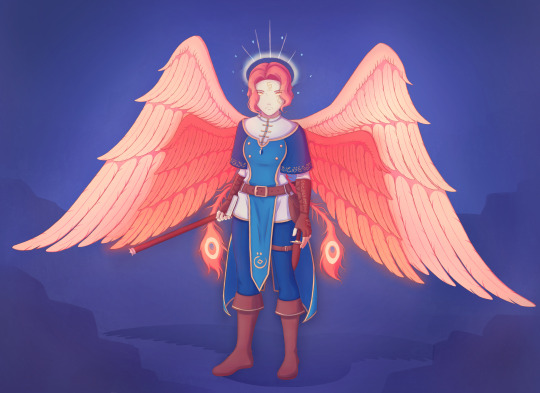
A drawing of my Knight-Commander, Emberkin Aasimar Nela.
As a bonus, I made a fast edit for a version without the mythic powers. Looking slightly less freaky.

#wotr#pathfinder wotr#aasimar#emberkin aasimar#wotr commander#pwotr pals#pathfinder 1e#pathfinder character#pathfinder wrath of the righteous#i must use this chance i don't quite hate it YET#a shadow's art
39 notes
·
View notes
Text
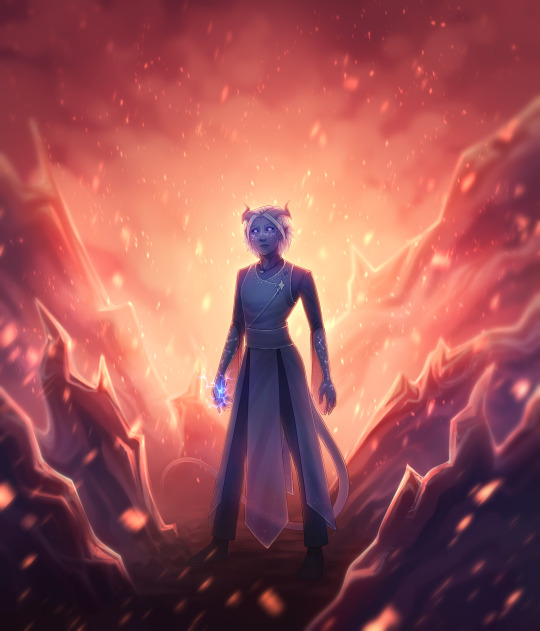
“You think that I’m weak because I wasn’t trained like you. You’re going to regret underestimating me.”
Some post-campaign stuff with Seren ✨
30 notes
·
View notes
Text


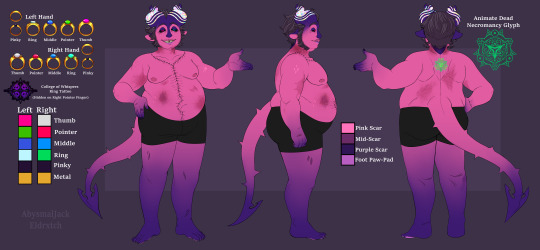
I've been working on this reference for the past week, and it's finally finished \o/
21 notes
·
View notes
Text

I'm playing a novakid in a pathfinder 1e campaign named Mercury. She's a sheriff for hire!
#lawful good#lg#novakid#pathfinder#pathfinder 1e#ttrpg#ttrpg oc#starbound#accurate guns#law#trigger discipline
25 notes
·
View notes
Text
Demon Lord, Orcus

Image © TSR Inc, by Todd Lockwood.
[Sponsored by @tar-baphon. Orcus is one of the iconic D&D villains, and through the SRD and plausible deniability (he's a Roman god!), he's in Pathfinder as well. In Pathfinder, he is deliberately not a power player, and my flavor text takes that already metatextual decision and runs hog wild with it.
A note on the art: I feel like Orcus is emblematic of when D&D was seen as dangerous, and this piece absolutely feels like it should be the cover of a Black Sabbath album. It's no surprise that I was fascinated with the anti-D&D strain of the Satanic Panic when I was a kid. Also, although there has been some course correction in the 5e era, there's a trend with Orcus in a lot of art, including his official Pathfinder depiction, of making Orcus buff. Let Orcus be fat!]
Demon Lord, Orcus
CR 28 CE Outsider (extraplanar)
This humanoid is a corpulent giant with skin mottled like a decaying corpse. He has great black bat-wings growing from his shoulders, hooves for feet, and the head of a goat. He clutches a short staff, tipped with an oversized human skull.
Orcus, Prince of Undeath
CE male demon lord of death, necromancy and wrath
Domains Chaos, Death, Evil, Magic
Subdomains Demon, Divine, Murder, Undead
Favored Weapon heavy mace
Unholy Symbol a goat’s head with curving horns
Worshipers liches, necromancers, sapient undead
Minions boneclaws, deathdrinkers, demons, other undead
For information on his Obedience and boons for his worshipers, see Book of the Damned
Orcus is one of the most powerful demon lords in the Universe. But not on Golarion. On that world, his is one of a number of undead cults, and not nearly the most popular. Orcus has a clear hierarchy to what undead he considers truly worthy, with those created from contagion seen as inferior to accident, and those inferior to those who intentionally seek out undeath. His most dedicated worshippers on Golarion are liches, some of whom have learned the secret of crafting a phylactery by teasing apart the Prince of Undeath’s wisdom from his threats. The followers of many other undead-focused religions, particularly vampires and ghouls, see Orcus as pretentious and unworthy of dedication, although few are foolish enough to directly oppose him.
Orcus himself knows that his star has fallen. In his extensive research into planar lore, Orcus has learned that he was once the most feared being in another universe, who went on a killing spree that left several gods dead and an entire race of lawful outsiders duped into being his pawns. That Orcus cannot accomplish this level of power in this version of reality vexes and frustrates him, and he takes his rage out on his minions as much as he does his foes.
Orcus is a genius tactician, although his temper sometimes gets the better of him. He enjoys combat as a distraction from his cosmic-level sulk, and as a way of expressing his power over others. He typically opens combat with a time stop to summon allies and cast defensive spells on himself, and then unleashes a potent death effect as soon as the duration expires. Against creatures that can resist his negative energy and poison, he uses dispelling magic. On more than one occasion, Orcus has beaten a cocky archmage to a pulp by centering an antimagic field on himself and wading into combat.
Orcus in the Great Game
Orcus’ response to the brewing theomachy between Mormo and Lamashtu is cautious optimism. He desires more power in the Abyss, and Lamashtu could open the door for him to seize it. Kabriri and Zura are at the top of Orcus’ hit list, but views a direct assault on them as currently too risky to be worth the effort. If one of them were to make a move against Lamashtu and be punished for it, or if they were struck down in the scramble for power following Lamashtu’s (theoretical) demotion or demise, Orcus would happily swoop in to finish them off. And if Mormo is capable of legitimately slaying a god, Orcus will be very keen to study her techniques.
Wand of Orcus (major artifact)
The Wand of Orcus is the Prince of Undeath’s scepter of office, and it never leaves his side. Lesser versions have appeared in the Material Plane, often created by Orcus or one of his high-level clerics. The real Wand of Orcus is a Huge +5 anarchic, unholy heavy mace. In the hands of a demon, it grants a +4 profane bonus to Armor Class. The first time the Wand of Orcus strikes a living creature in a round, that creature is subject to a slay living spell (DC 30).
Weight 24 lbs.; CL 25th
Demon Lord, Orcus CR 28
XP 4,915,200
CE Huge outsider (chaos, demon, evil, extraplanar)
Init +11; Senses arcane sight, darkvision 120 ft., detect good, detect law, Perception +48, true seeing
Aura frightful presence (120 ft., DC 36), undead obedience (120 ft., Will DC 36), unholy (DC 28)
Defense
AC 47, touch 23, flat-footed 40(-2 size, +7 Dex, +4 deflection, +4 profane, +24 natural)
hp 709(33d10+528); regeneration 30 (deific or mythic)
Fort +31, Ref +29, Will +34
DR 20/cold iron, epic and good; Immune ability damage, ability drain, charm, compulsion, death effects, electricity, energy drain, petrification and poison; Resist acid 30, cold 30, fire 30; SR 39
Defensive Abilities Abyssal resurrection, freedom of movement, negative energy affinity
Offense
Speed 40 ft., fly 60 ft. (average)
Melee Wand of Orcus +51/+46/+41/+36 (3d6+20 plus 2d6 chaos and 2d6 evil/19-20), claw +44 (1d8+7), sting (2d4+7 plus poison), gore (2d6+7) or 2 claws +46 (1d8+15), sting +46 (2d4+15 plus poison), gore +46 (2d6+15)
Space 15 ft.; Reach 15 ft.
Special Attacks epic spellcasting, powerful charge (gore, 4d6+22)
Spell-like Abilities CL 28th, concentration +38 (+42 casting defensively)
Constant—arcane sight, detect good, detect law, freedom of movement, true seeing, unholy aura (DC 28, self only)
At will—animate dead*, astral projection, blasphemy* (DC 27), circle of death* (DC 28), create undead, enervation*, greater dispel magic, greater teleport, plane shift* (DC 25), telekinesis* (DC 25), unholy blight* (DC 24)
3/day—control undead (DC 29), create greater undead, energy drain (DC 31), finger of death* (DC 29), quickened greater dispel magic, quickened harm*, summon demons or undead, symbol of death (DC 30)
1/day—power word kill*, time stop*, true resurrection, wail of the banshee (DC 31)
* Orcus can use the mythic version of this spell-like ability in his domain
Spells Prepared CL 20th, concentration +32 (+36 casting defensively)
9th—energy drain (DC 33), etherealness, mage’s disjunction* (D, DC 31), overwhelming presence (DC 31), soul bind (DC 33), wail of the banshee (DC 33)
8th —cloak of chaos (DC 30), fire storm* (DC 30), greater spell immunity, horrid wilting (DC 32), orb of the void* (DC 32), protection from spells (D), unholy aura (DC 30)
7th —control weather, destruction (DC 31), greater scrying (DC 29, x2), repulsion, spell turning (D), waves of exhaustion
6th —antilife shell, antimagic field (D), banshee blast (DC 30), blade barrier* (DC 28), geas/quest, harm* (DC 30), mass bull’s strength
5th —dispel good (DC 27), flame strike (DC 27), greater command (DC 27), mass ghostbane dirge (DC 27), righteous might, suffocation (D, DC 29), vampiric shadow shield
4th —contagion (DC 28), death ward (D), divine power (x2), rest eternal, sending (x2)*, tongues
3rd —bestow curse (x2, DC 27), prayer*, protection from energy, rage (D, DC 25), ray of exhaustion, vampiric touch*, water breathing
2nd —bear’s endurance (x2), death knell (D, DC 26), desecrate, owl’s wisdom (x2), resist energy, spiritual weapon*
1st —bane (DC 25), divine favor (x2), entropic shield, identify (D), ray of enfeeblement* (DC 25), sanctuary (DC 23), shield of faith*
0th—bleed (DC 24), detect magic, light, read magic
*—Orcus may use the mythic version of this spell in his Abyssal domain
Statistics
Str 40, Dex 25, Con 42, Int 30, Wis 35, Cha 31
Base Atk +33; CMB +50; CMD 71
Feats Combat Casting, Combat Reflexes, Craft Magic Arms and Armor, Craft Rod, Craft Wondrous Item, Flyby Attack, Greater Spell Focus (necromancy), Greater Spell Penetration, Improved Critical (heavy mace), Improved Initiative, Hover, Multiattack, Mythic Spell Lore (B), Power Attack, Quicken SLA (greater dispel magic, harm), Spell Focus (necromancy), Spell Penetration
Skills Bluff +46, Craft (alchemy, weaponsmithing) +46, Fly +36, Intimidate +43, Knowledge (arcana, planes, religion) +46, Knowledge (dungeoneering, history) +43, Perception +48, Sense Motive +48, Spellcraft +46, Stealth +35, Survival +45, Use Magic Device +46
Languages Abyssal, Common, Draconic, Infernal, Necril, telepathy 300 ft.
SQ demon lord traits, master of death
Ecology
Environment any land or underground (Abyss)
Organization unique
Treasure triple standard (Wand of Orcus, other treasure)
Special Abilities
Aura of Undead Obedience (Su) Any undead creature within 120 feet that attempts to make a hostile action against Orcus must succeed a DC 36 Will save or be unable to take that action, wasting it. The save DC is Charisma based.
Epic Spellcasting (Ex) Orcus gains Mythic Spell Lore as a bonus feat. Once per day, he can use one of his spell-like abilities or spells as if it was a mythic spell without spending a use of mythic power. This allows him to use a mythic spell or spell-like ability outside of his Abyssal domain, but he cannot augment that spell or spell-like ability by spending additional uses of mythic power.
Master of Death (Ex) Orcus applies his Spell Focus and Greater Spell Focus (necromancy) feats to his spell-like abilities. Death effects created by Orcus, including the Wand of Orcus in his hands, ignore immunity to death effects except for those granted by creature type, or from deific or mythic sources.
Poison (Ex) Sting—injury; save Fort DC 42; duration 1/round for 4 rounds; damage 1d6 Str and 1d6 Con; cure 2 consecutive saves. A creature reduced to 0 Str by Orcus’ poison cannot breathe and begins to suffocate. The save DC is Constitution based.
Spells Orcus can cast spells as a 20th level cleric, and can prepare necromancy spells from the sorcerer/wizard list as if they were cleric spells. He gets access to domain slots, and can fill them with spells from any of his domains or subdomains. He can also spontaneously cast inflict spells as an evil cleric can.
Summon Demons and Undead (Sp) When Orcus summons demons, he can also summon undead creatures.
#orcus#demon#demon lord#pathfinder rpg#pathfinder 1e#D&D#satanic panic#todd lockwood#undead#outsider#necromancer#sponsored post#demigod
93 notes
·
View notes
Text



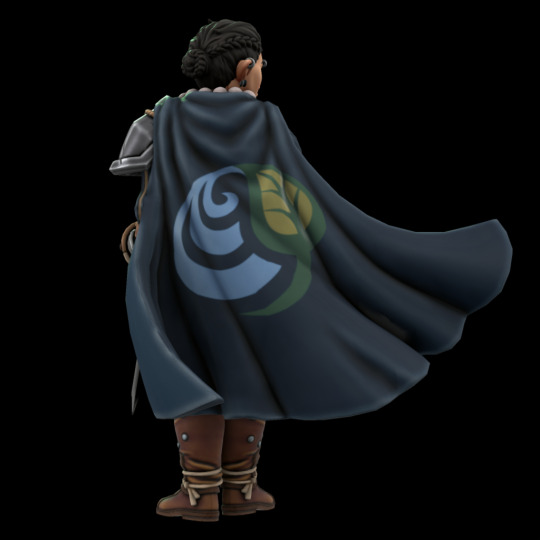
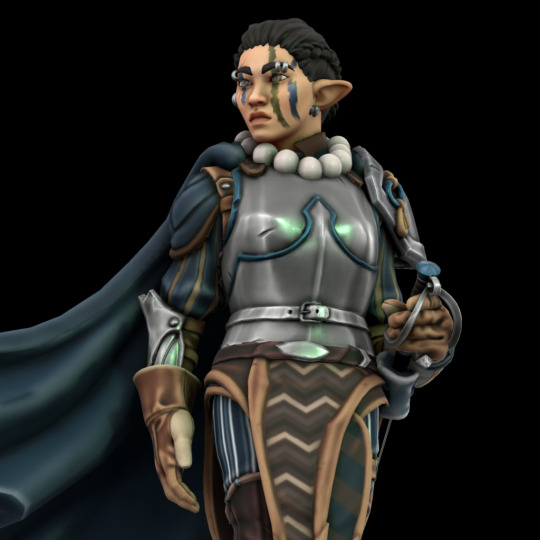

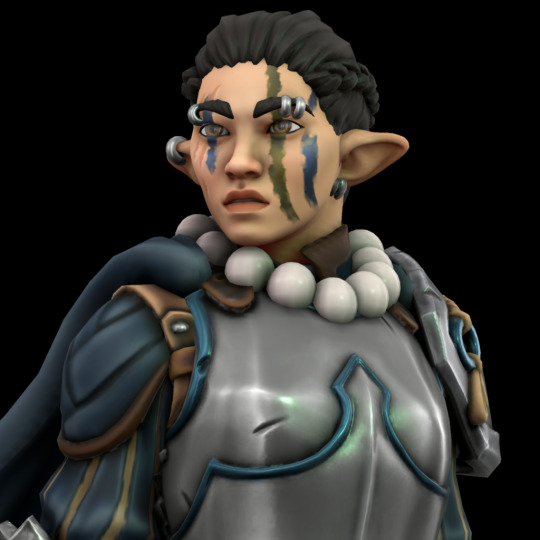

Argent Vestrus (he/they)
half-elf - magus - blade bound - river kingdoms daredevil
sorry i love this little guy. they are a redo of this character with a more refined aesthetic, vision, palette, story, etc. i wanted to make him less "swashbuckler" and more "river kingdoms pirate who accidentally became knight-commander", and i also wanted to emphasize their gozren faith more!!! they still were mendevian nobility who absconded and they still have an annoying little sister (marielle my beloved) and i am in the mood to write about him so you will probably hear more. anyways some FUN lore about Gozreh and why i chose them as a deity below. how it influenced design choices. etc.
from the pathfinder wiki
"Gozreh appears as a colossal humanoid (often of Mwangi ethnicity) whose lower body trails away into a mass of roiling elemental matter. While the deity transcends gender in nature, in such depictions the gender presented depends on their aspect. Their female form is associated with the sea, and appears as a young and beautiful woman with wild green hair of sea foam whose torso merges with the roiling sea. Their male form represents the winds and clouds, and appears as a weathered old man with a long white beard whose lower body melds into a storm cloud. At coastlines, images of Gozreh present these two forms reaching up from the sea and down from the heavens, whose fingers only barely miss touching each other in midair."
"Gozreh shows their favor by the sudden appearance of a gentle breeze that carries with it the smell of blooming flowers, the unexpected sound of waves crashing on a shore, or dreams involving a specific, and unusual-looking animal. Those blessed by Gozreh find navigating at sea easier, can breathe underwater, and walk with such a light step from Gozreh's winds that some can fly.
Polluting or otherwise spoiling the natural order draws Gozreh's displeasure, which manifests in the sudden appearance of extremely localized storms or other bad weather, being watched or hounded by birds or beasts, or the continuous taste of blood in one's mouth. Lightning seems to seek people who have been cursed by Gozreh, the waters seem to try to drown them, and those Gozreh most displeases are so shunned by nature itself that animals and plants fear or hate them on sight—even their own animal companions or familiars, who abandon them."
"Gozreh's many representations reflect their fluid gender, which attracts followers across a wide range of identities. The faith places little emphasis on marriage, with some worshipers choosing celibacy in isolation to focus on their communion with nature. They can also be blunt, if insightful, in manner and biased toward action over deliberation."
"Priests of Gozreh are rugged folk, and many are hermits. Most who interact with society do so serving on the crews of far-ranging ships, where they are known as gale-speakers and considered lucky boons to have aboard. Gale-speakers spend most of their time at sea and walk on land only to find another ship.
Followers are expected to grow their hair or beards, and often braid in seaweed, natural items, and strands of white cloth. Some also mat their hair for months in order to carve it out as nesting material for small creatures; fewer even allow animals to nest in their still-attached hair.
Formal raiment is usually long robes of sea-green, storm-grey, or sky blue color, decorated with coral or pearls. Although most druids in the Inner Sea region are followers of the Green Faith, a significant minority of them worship Gozreh instead."
"Due to being both aquatic and aerial beings tied to both the sea and rain, tidehawks are often considered favored creatures of Gozreh. There is disagreement among sailors regarding whether sighting a tidehawk is a good omen or a bad one, since the ocean, tidehawks, and Gozreh are all quick to shift between calm and fury."
#oc: argent#argent vestrus#pwotr#knight commander oc#river kingdoms#pathfinder#pathfinder wotr#pathfinder 1e#gozreh#pwotr pals#pathfinder wrath of the righteous#pathfinder: wrath of the righteous
23 notes
·
View notes
Text
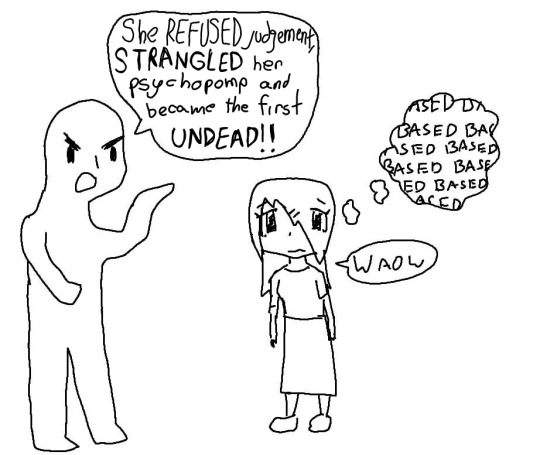
Thinking about Urgathoa
71 notes
·
View notes
Text
Healthy Boss Template (CR +3)
Wait, why did a giant health bar just appear in the sky?

Artwork by Jeff_Chee_471 on Reddit.
D&D and Pathfinder have a really unusual idea of what a "boss" is compared to, like, any video game ever made. They often tend to just take an enemy that would be part of a group of normal enemies if you were about six levels higher. When they do something more unique, it still tends to be balanced like that. Tons of offense, not that many hit points, but often extremely hard to hit. Adventure designers often try to make up for this design by making a boss weaker but giving it minions, but that doesn't change the fact that there's really no concept of a creature that's inherently a "boss creature" in this game.
And sometimes that's fine. But sometimes you just want a big chunky fight that's balanced more like how a video game boss is balanced: only a little more damage than other creatures, but way more health, and the ability to recover if you do nasty stuff like stun it. Something that lets the players go all-out using their abilities, and rewards them for doing so, instead of having to spend most of the fight just focusing on not getting attacked, because they know one attack can take them out.
This template isn't a global solution. It'll get old, and if you reuse it too much, players will find strategies that bypass it. That's why I design so many different boss monsters that each work differently. But if you want to convert an existing monster into a boss, this is one way to do so without a lot of effort, and without just giving it the advanced template and several fighter levels to max out its offense.
Some of the options for different abilities are there to deal with different kinds of player strategies, rather than because they're appropriate for different kinds of bosses. If your PCs use vital strike, give it vital negation. If they use combat maneuvers, give it reset stance. If they cast a bunch of spells on the terrain, give it undo. If they rely on hungry pit, give it escape to nowhere. Don't feel bad about using this template specifically to counter them, since the inflated HP and the limited uses of these special abilities mean that the players' strategies will still be useful, they just won't instantly win the fight.
Healthy Boss
Healthy boss is an inherited template that can be applied to any creature.
Challenge Rating: Same as the base creature + 3.
Hit Points: A healthy boss's hit points are three times as high as the base creature's.
Initiative: A healthy boss gains a +10 bonus to its initiative.
Defensive Abilities: A healthy boss can never be surprised, and is not considered flat-footed before it has acted in combat.
Special Abilities: A healthy boss gains 1 of the following special abilities:
Bolstering Cry (Ex)
Twice per day as a move action, a healthy boss can grant all allies within 60 ft. a number of temporary hit points equal to its new challenge rating. When it does so, it also suppresses the following conditions on affected allies other than itself for 1 round: blinded, confused, entangled, fatigued, exhausted, nauseated, paralyzed, shaken, sickened, staggered, stunned. The healthy boss does not need line of effect to these allies, but they must be able to either see or hear it.
Second Wind (Ex)
Five times per day as a free action at the start of its turn, a healthy boss can gain a number of temporary hit points equal to its new challenge rating. These temporary hit points last for 10 minutes. It can only use this ability only once per round.
Vital Negation (Ex)
Once per round, a healthy boss can halve the damage of a single incoming source of damage. It can choose to use this ability after hearing the amount of damage that it would take. This does not require an action.
Additionally, a healthy boss gains 2 of the following other special abilities:
Aura of Recovery (Su)
The healthy boss gains a 40-ft. aura. At the end of each of the healthy boss's turns, one of the healthy boss's allies within this aura (including itself) gains a new saving throw against any one ongoing harmful effect that initially allowed for a saving throw.
Escape to Nowhere (Su)
Once per day, at the end of an enemy's turn, a healthy boss can escape to the ethereal plane, as if using ethereal jaunt. This does not require an action. It remains in the ethereal plane during its next turn. At the start of its second turn after using this ability, the healthy boss returns to the plane it was on, but is staggered during that turn.
Legendary Resistance (Ex)
Once per day, when a healthy boss fails a saving throw, or when an enemy succeeds on a check against the healthy boss's spell resistance, the healthy boss can expend its legendary resistance to treat the roll as if the healthy boss had succeeded on the saving throw or the enemy had failed on the check against spell resistance. A healthy boss with a total challenge rating of at least 9 gains a second use of Legendary Resistance per day, and a healthy boss with a total challenge rating of at least 18 gains a third use of legendary resistance per day. This does not require an action.
Reset Concentration (Ex)
Once per day, when a healthy boss fails a concentration check, it can steel its mind against future distractions, gaining a +10 bonus on concentration checks for the next 10 minutes. This does not require an action.
Reset Stance (Ex)
Once per day, when a healthy boss starts its turn prone or grappled, at the start of its next turn after being successfully subjected to a combat maneuver other than trip or grapple, it can spend a move action to stand up, free itself from any grapples, pick up a single item within its reach, end the effect of a dirty trick maneuver, and move up to its move speed without provoking attacks of opportunity. Upon using this ability, the healthy boss also gains a +5 bonus to its CMD and a +10 bonus to Acrobatics, Climb, Ride, Swim, and Fly checks for the next 10 minutes.
Undo (Su)
As a standard action, once every 3 rounds, a healthy boss can revert the effects of any number of ongoing or instantaneous magic spells that are affecting itself, other creatures, or the surrounding environment. Each spell effect it attempts to undo must be within 60 ft. of the healthy boss, and must have been applied during the last 10 minutes. Even instantaneous spells can be reverted with Undo, but damage is not reverted.
To attempt to undo a spell, a healthy boss makes a caster level check against a DC of 6 + the effect's caster level, using its hit dice as its caster level. If successful, the ongoing spell ends, or the effects of the instantaneous spell are reverted.
56 notes
·
View notes
Text
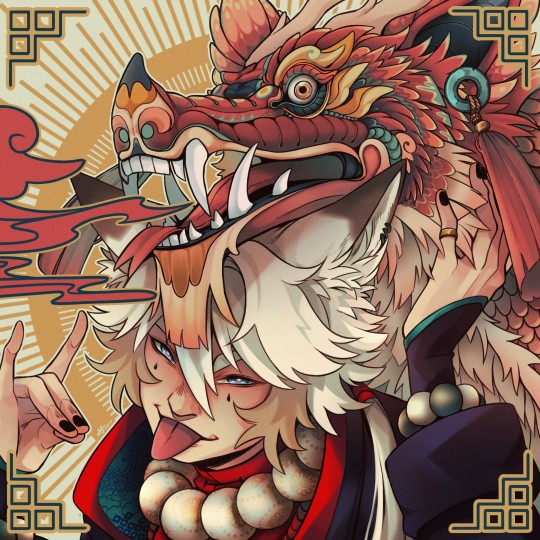
Some late little lunar new year piece with Lixin
#lixin#pathfinder 1e#my art#my art and animations#dnd#dungeons and dragons#dnd5e#oc#dnd character#dnd art#pathfinder#pathfinderrpg#kitsune#fox#dragon#lunar new year
23 notes
·
View notes
Text
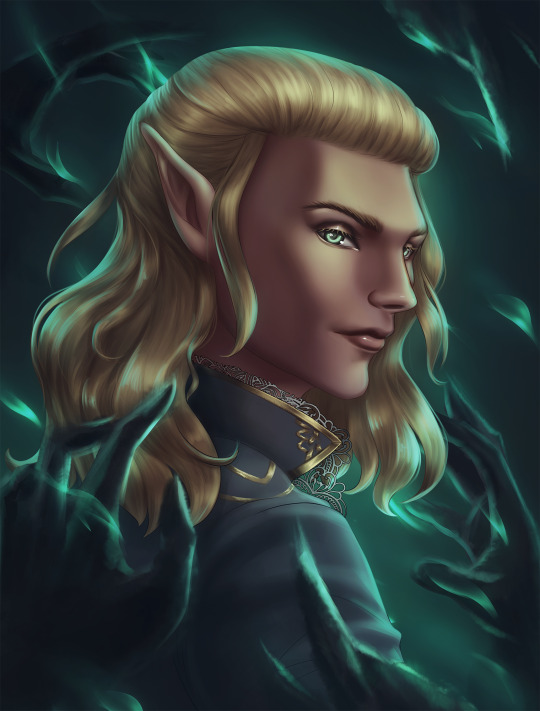
Prince not so charming and other things xd
#pathfinder#monowska#ttrpg#pathfinder 1e#daeran arendae#daeran#aasimar#dnd character#oracle#other#pathfinder wrath of the righteous#pathfinder wotr#wrath of the righteous#handsome#digital art#portrait#fantasy rpg#rpg ressources
77 notes
·
View notes